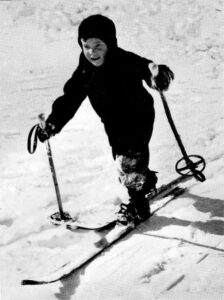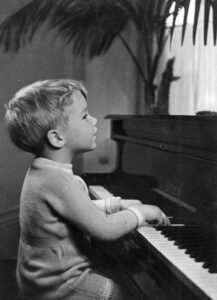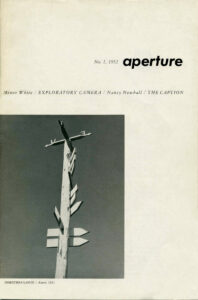Translator: Ravita Buaphuan
It was more than 70 years that Ansel Adams had been active as a black-and-white photographer.
He was not only regarded as the master of landscape photography, who invented the “Zone System” or exposure measurement from the lightest part to the darkest part, the theory that all photographers acknowledge.
But also, his pieces of work that project the changes of forests in different areas could provoke a lot of people to pay their attention to woods, mountains, and streams which were gradually decreasing as a result of human’s threat, sparking movements for nature conservation throughout the United States.
Many people might wonder, how could only a few of black-and-white photos create such an impact. We, The Normal Hero, together with D1839 would take you into the course of this legendary photographer life.
01 The Path of Hyperactive Kid
No one would have expected that a hyperactive kid could grow up to be a great photographer.
Ansel was born in San Francisco. Despite having a wealthy family, his childhood was not so lively. As when he was four, there was a great earthquake that made the kid lose his balance, fall and crash into the garden wall until his nose was dishaped. The doctor of his family suggested him to leave it like that and wait until he grew up to take a surgery, but eventually he had never consulted a surgeon again throughout his life.
In the following year, his family’s goldmine business went bankrupt. Charles Adams, Ansel’s father, rebounded to inherit the wood business of his grandfather. But it did not make much profits, as he could not catch up with a fierce game of the business world. His mother was not pleased that her husband could not manage to revive their financial stability, and consequently suffered depression throughout her life.
- Young Ansel Adams
In the meantime Ansel became an isolated kid, prone to sickness and seldom cried without a cause. He turned into a child with anxiety and no confidence in socializing. Though his doctor suggested he sleep in a dark room in the afternoon for two hours everyday, the sound of waves and gardeners from the outside put even more stress on him.
The worst part was that he could not concentrate on studying like other kids and was often punished by teachers. He was dismissed from a lot of schools for being fidget. The doctor diagnosed him as hyperactive, and also suffered from dyslexia, a disorder with difficulty to read, write or spell.
“There was one day, I uncontrollably bursted out laughing. At first everyone in the class found it humorous. But after that everyone felt scared. I stood up, pointed at the teacher and roared out insults. I could barely pause for breathing throughout the time I went on a rampage. Out of panic, my mother rushed to take me home and detained me for one week. Eventually my father realized that sending me to schools was fruitless. I therefore had to study at home under his monitoring.”
Charles dedicated all his love and energy for his son. He taught French and Algebra until the kid turned 12 and got interested in music after hearing a piano sound from the neighborhood. Though it was challenging for a hyperactive kid, Charles went for full support by hiring his son a teacher and spent more than 6,000 dollars for a piano, hoping that one day the kid would grow up to be a classic pianist.
As for Ansel, his father was the greatest person. Even at the age of 80 he still talked about his father in a respectful manner, contrastingly from his mother whom he had never understood.
As a result of getting into music, Ansel became more concentrated, disciplined and determined, which were great benefits when he stepped into the world of photography.
The crucial turning point came in 1916 when Ansel fell ill. His aunt gave him the book In the Heart of the Sierras by James M.Hutchings which has a setting in Yosemite, a huge granite valley in California. Ansel was fascinated in the storytelling and images of this place, including the adventure of the cowboys and the Native Americans to find treasure of gods.
After recovering, Ansel tried to beg his parents to go there for a vacation trip. The landscape, pine forest, waterfalls, rivers, mountains, lakes all left such a great impression on the young boy. It might not be wrong to call it love at first sight.
At that time, Charles gave Ansel a mini Kodak No.1 Box Brownie for him to take photos of the grand forest.
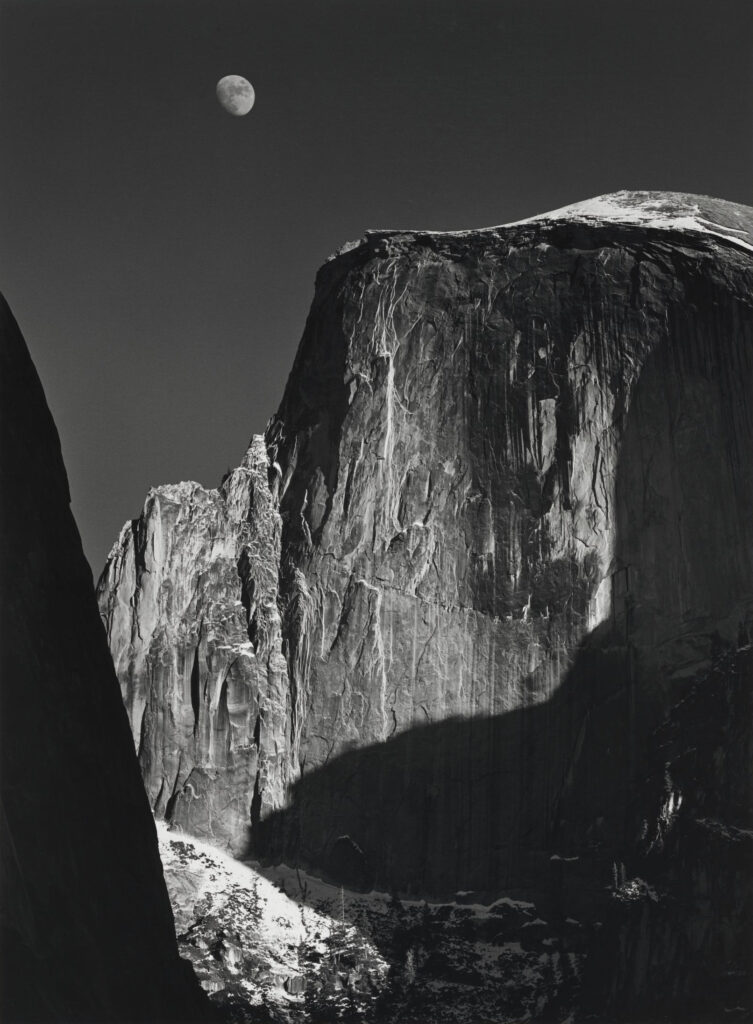
Moon and Half Dome ©Ansel Adams
“After reading the manual, I immediately began a survey. I climbed an old stump near our tent to take a picture of Half Dome (the top of the granite rock which is the symbol of Yosemite, rises about 5,000 feet from the valley floor). I looked at the top of this legendary site and pressed the shutter button.”
Ansel was specially attached to this valley. In 1919 he had Spanish Flu, a severe pandemic that deprived the lives of more than half a million american population. He returned to this place and it turned out that the fresh air could redeem his health. From there the Adams came here every year.
Here Ansel also met a lot of hikers and joined The Sierra Club, an environmental organization of the United States, and worked there as a keeper of the office in summer, answering questions, monitoring the library, installing cables behind Half Dome to facilitate travellers to climb up easier, organizing trekking trips called High Trip and taking a hundreds of members for surveys in Sierra Nevada for a month, while Ansel took part as a photographer throughout the trip.
It was this period that Ansel got to take photos of trekking routes, and also learned how to use a flash to create variation in photo taking. His works were published in Sierra Club Bulletin, and that brought him a chance to hold his first solo exhibition.
Despite how much he enjoyed projecting the beauty of Yosemite, Ansel did not consider getting into the profession of photographer, as the young man still had a big dream of becoming a professional pianist.
02 Becoming a Professional Photographer
The main reason for Ansel to be committed in music was that everyone knew how he was gifted for it. He practiced hard for 6 hours per day throughout 12 years and started a band called Milanvi Trio with his violinist and dancer friends, performing in a lot of events.
However, the result was not satisfying. Realizing that the chance to reach the national level was desperately low, he decided to turn his back to his music career, and started to pursue the path of photographer instead.
At the beginning Ansel’s photo had the features of paintings: looking blurry, using foxy light with techniques to let the photo express emotions the best. Later on he found out that photography which is clear and reflects the reality of the landscape is even more powerful.
- Sierra Meadow ©Ansel Adams
- Grove of Tamarack Pines ©Ansel Adams
He began to learn about the significance of light that can affect feelings and emotions in the photos, and ventured to risky spots in order to obtain unique shots. One dream that he wanted to achieve was to take a perfect shot of Half Dome.
Before that Ansel had surveyed Half Dome many times. One of his favorite photos of it was the upside down, which he accidentally took while he was about to fall off a stump. He sometimes climbed up to the glacier in Yosemite to oversee the place’s landscape from a wide angle.
Finally, in 1927 Ansel successfully took a photo called “Monolith, the Face of Half Dome”. That time he carried a backpack that contained filters, lenses, and films which weighed more than 40 pounds up to a 3,500-feet mountain. It took him several weeks to look for the best angle for a photo.
While having lunch in the meantime of waiting for the sun to rise up high enough and shine over the whole cliff, Ansel began shooting.
In the first time he used a yellow filter to darken the blue sky. But after releasing the shutter, he realized that something was not right.
“The shadow on the cliff seemed like the sky. It was grey. It must be a picture of Half Dome that is sharp, but it might not be able convey the feelings I have well enough.
The second time he changed to a crimson filter which heavily darkened the sky color and defined the color of snow on the cliff. For Ansel, it was such a beautiful photo. He wrote a letter to his wife Virginia Best that ‘The outcome was beautiful, extraordinary and unique’.
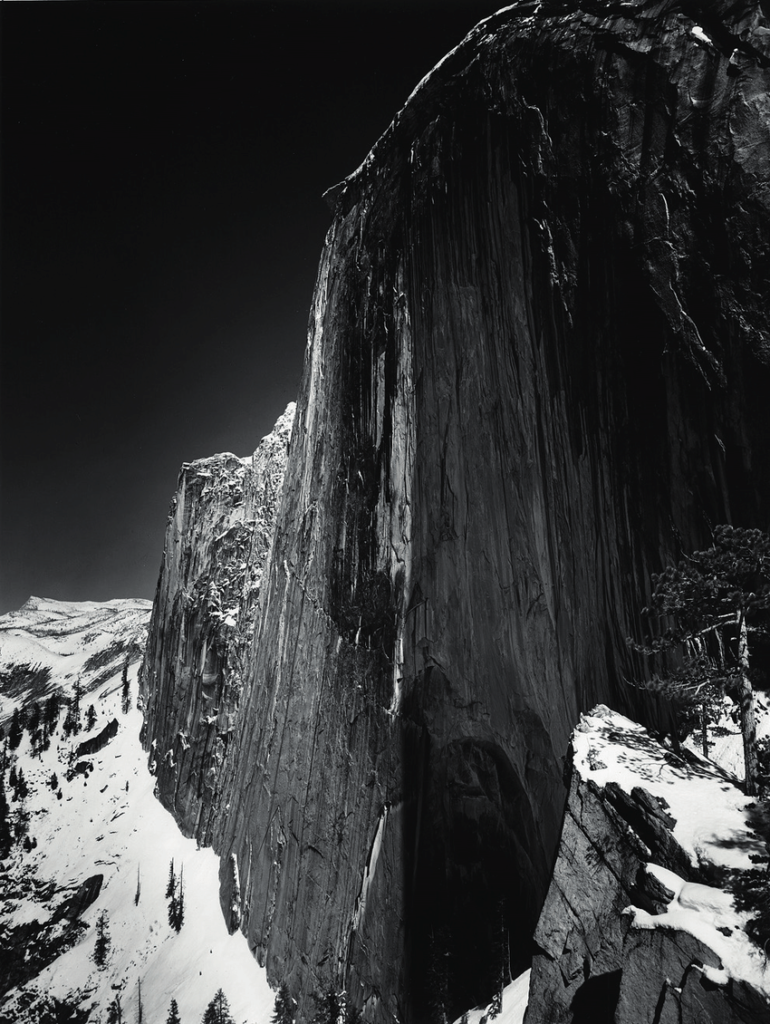
Monolith The Face of Half Dome ©Ansel Adams
The image “Monolith, the Face of Half Dome” became the work that entirely changed Ansel’s life. It was also the starting point of founding Zone System theory, a theory that became a bible for photographers all around the world up to nowadays.
Most importantly, the photo brought him to Albert Bender, the business owner of Bay Area Insurance and a major artist sponsor who encouraged him to compile 18 images and publish them in a photobook called Parmelian Prints of the High Sierras for 100 copies. It turned out that the book was so saleable that it was sold out in only a few days.
Ansel became more widely known. He got to hold an exhibition in New York and stepped into the industry of commercial photography. Though he did not really enjoy the work, as the given working hours were too limited, and style of nature photography and studio photography were nothing alike, but at least the young man could acquire new skills, whether observing, composition, dealing with assistants and clients, and also experiences from senior photographers who were willing to provide him knowledge. Eventually all of these became a great foundation when he had to climb up high mountains for taking wide landscape photos.
03 The Conservationist Photographer
The other characteristic of Ansel is how the works he presented look different from the type of photos we are familiar with. While others aimed to project the beauty of landscapes, he chose to present the realistic change of nature, whether the drought of soil surface, dry trees, and the wasteful land, which were becoming even more serious problems that threaten the world in the future.
Many specialists said that during that era environmental issues were not in the public’s attention at all. The crisis that concerned people the most was the effect from World War I, namely poverty, famine, or injustice that happened everyday in society.
But thanks to the power of Ansel’s pictures that portray the stories from different forest areas, people are motivated to reconsider and realize that if no one takes action about this issue, it would become too severe to redeem.
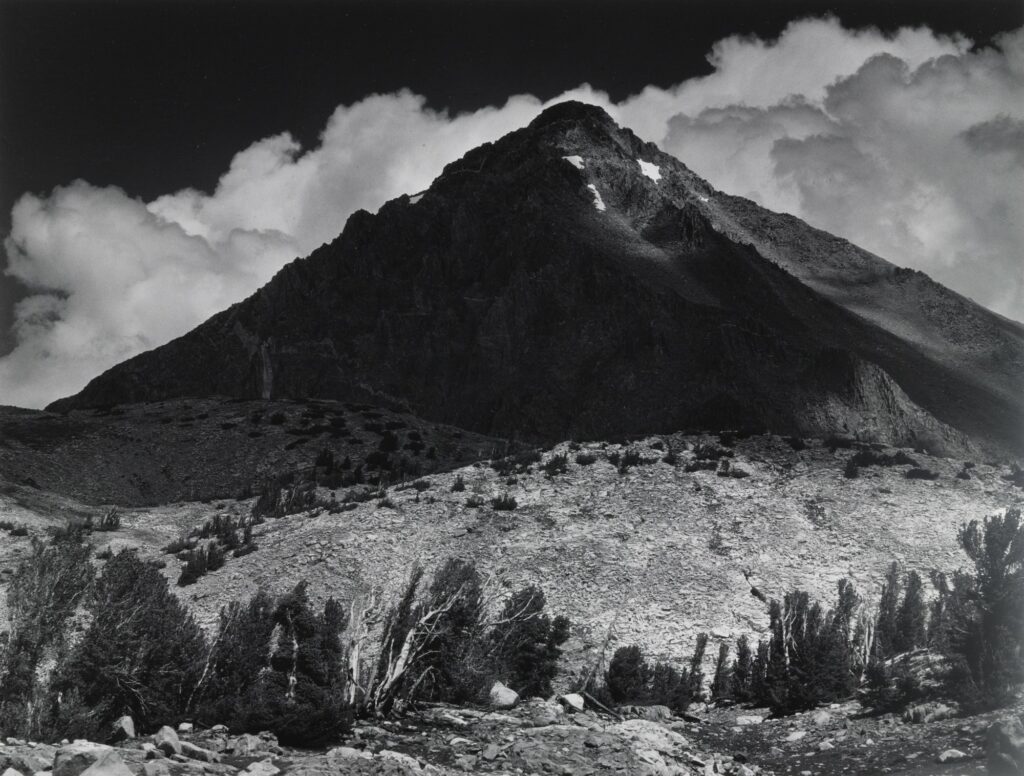
Mount Wynne, Kings Canyon National Park ©Ansel Adams
In 1936 during the exhibition “An American Place” Ansel was requested from the committee of The Sierra Club to be a representative of a conference about a national park in Washington D.C. He also needed to seek support from the senators to announce Kings Canyon, a nature traveling spot in the south of Sierra Nevada valley, as a national park. The committee also suggested Ansel to present them photos from the actual spot.
That time Ansel did not only meet the lawmakers but also Harold Ickes, Secretary of the Interior, who was a hardcore fan of him.
In the following year, Walter Starr, a wealthy businessman who was the main sponsor of The Sierra Club asked Ansel to produce a special photobook as a remembrance to his late son who passed away from an accident of hiking. As a result, the book Sierra Nevada : The John Muir Trail was launched.
Though published for only 500 copies, Sierra Nevada became one of the most influential books for the movement of conservationists. Ansel sent the book to Ickes, to which the minister gave it to the president Franklin D. Roosevelt, who favored the photos set so much that he kept it in The White House.
On 4 April 1940, Roosevelt signed the bill to announce Kings Canyon as a national park. Later on the head of the park wrote to Ansel Adams that, though having a small voice, the book left such a great impact. And if it wasn’t for the book, this campaign would not have been successful.
- First and Latest apeture
Ansel continued to contribute in conservationist work, like founding Aperture, a journal which focuses on creative photography, consecutively holding creative photography exhibitions almost every year, roaming to take photos in different forests such as Denali National Park and San Joaquin Valley.
He also took part in social movements. For example, in the photo set “Born Free and Equal”, Ansel photographed more than 100,000 Japanese – American people that were forced into Manzanar concentration camp located at the foot of Sierra Nevada hill. The project was a counteract to Japan’s attack on Pearl Harbor of the United States.
“My purpose was to show how much these people were suffering with this deadly injustice. They lost their property, career and had to build a community in such a desolate environment. For me Manzanar collection was regarded as a historical record, which I believe will be utilized in the future.”
After the work was showcased at a museum in New York. Ansel was labeled as ‘a traitor’ from the Americans who were hateful towards the Japanese. But he ignored them for believing in the dignity and equality of mankind, and proceeded to create new projects.
As a result of constantly publishing works that reflect social issues, Ansel became recognized as an environmental activist even more than a capable photographer.
04 Master of Black-and-white Photography
Apart from an outstanding role of a conservationist, another role that Ansel loved the most remained photography.
“People often feel surprised when I say I have never intended to take photos that directly concern environmental issues, even though I feel good being told that my photography is useful. I have never planned ahead of what to shoot. I just wanted to go see the world outside with a hope to find something that sparks me. No wonder that I would continue taking photos as long as I am still alive.
Ansel published a number of photography textbooks. He had a major role in establishing the Department of Photography at the Museum of Modern Art in New York, and also taught photographic techniques in a number of schools. One of his greatest works was inventing the Zone System, which is based on exposure planning and metering together with Fred Archer while teaching photography at The Art Center School, Los Angeles in 1939–1940
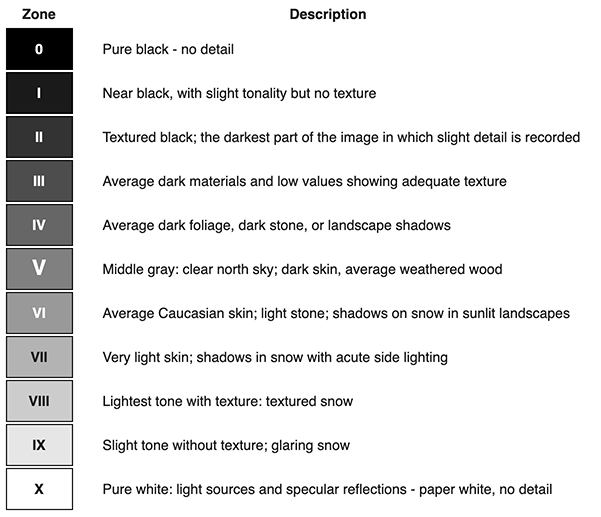
Ansel Adams’ Zone System © Wikipedia
He talked about the reason behind the invention of this theory. It started from how most students would try to duplicate the photographing method of their teachers. He therefore wanted to create a system or thinking process for his students to develop and create a work in their own style. Eventually the technique was effective and became a significant foundation for black-and-white photography for the next decades.
Besides, Ansel enjoyed creating his work in distinctive styles. He worked everyday whether taking photos, processing films, looking for new inspirations to create work.
For example, in the late afternoon on 1 November 1941, the senior photographer drove through a road in New Mexico state with his son. As he looked up to the sky and saw the moon floating above clouds that cover the mountains. He stopped the car and immediately took a photo to which he got only one shot, because while flipping the plate to take the second photo, the clouds and the moon had already disappeared.
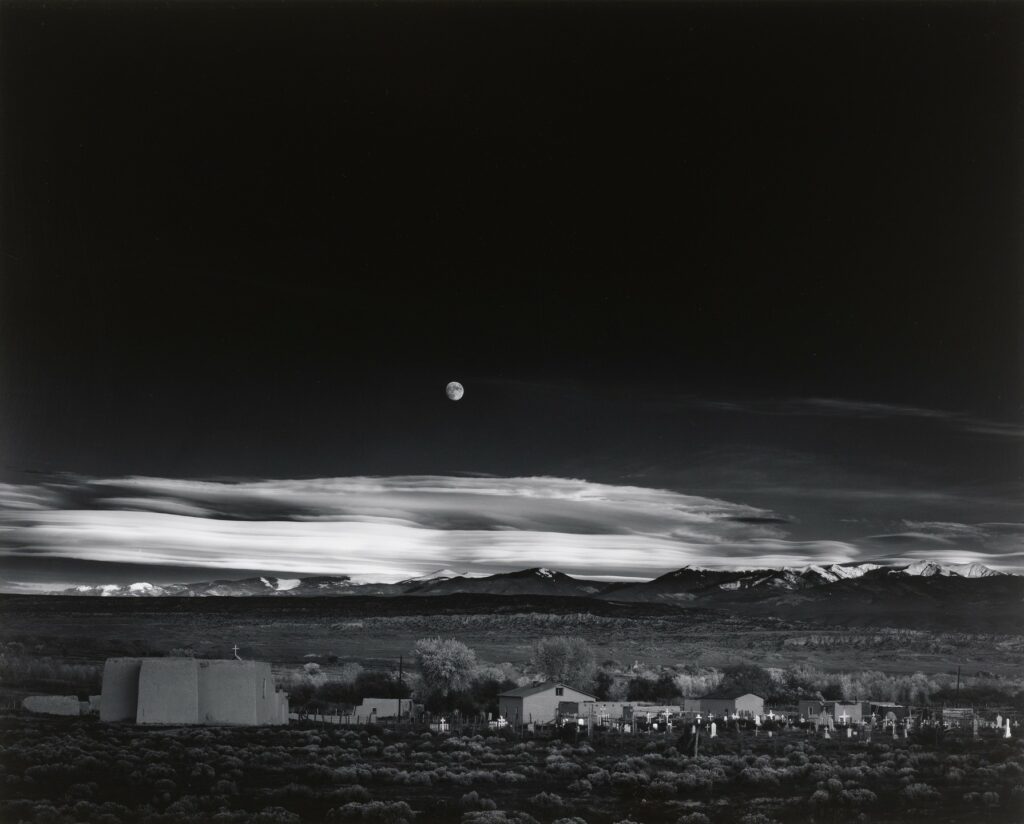
Moonrise over Hernandez ©Ansel Adams
The photo “Moonrise over Hernandez, New Mexico” became one of Ansel’s most expensive prized photos. The original copy was auctioned for more than 609,600 dollars, or approximately 25 million baht.
“Every photographer would always look for something around us… for the sake of creating artwork. Everyone has eyes and thoughts, but what we do not have in common is the ability to see with a heart, which is the thing that cannot be taught or inherited. Everyone must generate this power of their own and combine it with their work.”
“Sometimes I had to be concentrated and calm when facing immediate problems of taking photos. I admit that there were times that I had to improvise from my consciousness. Most of my pictures are the objects or things that caught my attention, things that are found, not made or constructed. It often happen as soon as I see it, and realize what is its value”
In the final years of his life, Ansel was still active in the environmental movement and photography. Every year he would travel to lobby the senators to appoint more preserving areas in forests and meet a lot of American leaders. In the year 1980, the president Jimmy Carter awarded him the Presidential Medal of Freedom, the highest class decoration of the United States, given to those who dedicated themselves for the sake of the public and the nation’s interests.
The rest of his time, if not traveling to Yosemite, he would spend his time in a darkroom, printing according to customers’ orders.
At the age of 80, Ansel found his final dream to accomplish, which is selecting his masterpieces to exhibit in a museum. Unfortunately the project was not accomplished, because Ansel passed away on 22 April 1984 at the age of 82.
Half a year after Ansel was gone, The Congress established the 200,000-acre land near Yosemite as a preserved area called The Ansel Adams Wilderness Area. In the next year, a 11,760-feet high mountain in the Yosemite National Park was named Mount Ansel Adams after him.
Though eventually Ansel was not there to hear all these stories, but for the photographer, this should be a reward that is worthy of his dedication for his passion throughout 7 decades.
References
- Documentary “Ansel Adams : A Documentary Film”
- Book “Ansel Adams : an autobiography by Ansel Adams and Mary Street Alinder”
- Website The Ansel Adams Gallery
- Website Public Broadcasting Service (PBS)
- Website Artsy
- Website Mental Floss
- Article “Ansel Adams, and 10 Things You Might (not) Know About Him”
- Facebook กล้องเก่า เล่าเรื่องใหม่ (“Old Camera, New story”)
- Magazine Shutter Speed, Issue 8, 1988 From Facebook of ณคเรศ ธีระคำศรี (Nakaret Theerakamsri)

